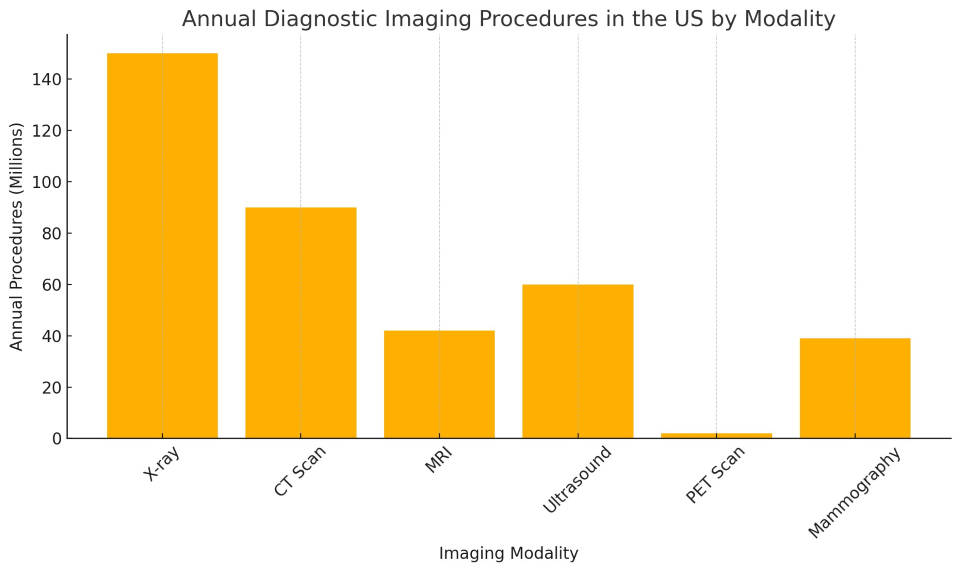Diagnostic imaging is one of the foundational pillars of modern medicine. It allows healthcare providers to see inside the human body in real time, identify problems, and guide treatment — often before symptoms even appear. In the United States, diagnostic imaging is not only essential for quality care but also a major driver of healthcare spending and technology innovation.
This article breaks down what diagnostic imaging is, why it matters, how it’s used in the U.S., and the challenges and opportunities facing the system today.
What Is Diagnostic Imaging?
Diagnostic imaging refers to a range of technologies that capture visual representations of the inside of the body. These images are used to diagnose, monitor, and sometimes even treat medical conditions.
These tools range in complexity, from the basic chest X-ray to advanced 3D MRI scans. Here's a closer look at the most common modalities:
Common Imaging Modalities
Diagnostic Imaging by the Numbers
The U.S. performs some of the highest numbers of imaging procedures per capita globally. In many clinical settings, imaging has become routine — even expected — as part of medical evaluations.
Annual Diagnostic Imaging Procedures in the U.S.

This volume reflects both the high level of access and the heavy reliance on imaging in American medicine.
How It’s Used in the U.S. Healthcare System
Diagnostic imaging is integral in nearly every care setting:
-
Primary care: Routine screenings like chest X-rays or mammograms.
-
Emergency departments: CT scans to evaluate head injuries, internal bleeding, or strokes.
-
Surgical planning: MRIs to map tumors or joint issues.
-
Chronic disease management: Imaging helps track diseases like arthritis, cancer, or heart failure.
-
Preventive care: Early detection is a key goal in imaging strategies.
For many patients, an imaging scan is often the first step in identifying a problem and deciding on a treatment plan.
Cost, Insurance, and Payment Structure
Imaging services in the U.S. are among the most expensive in the world, largely due to technology costs, regulatory requirements, and fragmented care systems. A single MRI scan can range from $500 to $3,000 depending on location and insurance coverage.
Who Pays for Imaging?
-
Private Insurance: Often covers imaging but may require prior authorization.
-
Medicare/Medicaid: Covers medically necessary scans, with limits and oversight to prevent overuse.
-
Out-of-Pocket: Patients without insurance or with high deductibles often delay or skip imaging due to costs.
Imaging is often a key battleground in discussions around healthcare affordability and transparency.
Regulation and Oversight
Diagnostic imaging in the U.S. is regulated by several agencies to ensure patient safety and quality:
-
FDA: Oversees the safety and effectiveness of imaging devices.
-
ACR (American College of Radiology): Accredits imaging facilities and promotes best practices.
-
CMS (Centers for Medicare & Medicaid Services): Sets payment policies and promotes appropriate use through programs like the Appropriate Use Criteria (AUC) initiative.
While regulation is critical, it also adds administrative burden, particularly in smaller practices.
Workforce and Infrastructure
Diagnostic imaging depends on highly trained professionals:
-
Radiologists: Physicians who interpret images and consult on diagnosis.
-
Radiologic Technologists: Operate the machines and ensure quality image capture.
-
Medical Physicists: Maintain imaging equipment and radiation safety.
There’s currently a shortage of radiologists in many parts of the U.S., particularly rural areas, which contributes to delays in diagnosis and overburdened urban centers.
Tele-radiology has emerged as a solution, allowing remote image interpretation, but it also raises concerns about continuity of care and outsourcing.
Overuse and Unnecessary Scans
One of the biggest challenges in U.S. imaging is overutilization. Studies suggest that 20-30% of advanced imaging (like MRIs and CT scans) may be medically unnecessary.
Why does this happen?
-
Defensive medicine: Doctors order scans to avoid lawsuits.
-
Patient expectations: Many patients believe more testing equals better care.
-
Lack of coordination: Providers in different systems may repeat tests if they can’t access prior results.
This overuse drives up costs and can lead to a cascade of additional testing and procedures.
Innovations and the Future of Imaging
The field of diagnostic imaging is rapidly evolving, with several promising trends:
-
Artificial Intelligence (AI): Algorithms now assist in identifying abnormalities like lung nodules or brain bleeds, speeding up workflows and improving accuracy.
-
3D Imaging and Augmented Reality: Helps surgeons visualize complex anatomy before or during procedures.
-
Point-of-care Ultrasound (POCUS): More physicians are using handheld ultrasound devices in real-time, improving access in remote or emergency settings.
-
Interoperability Improvements: Efforts are underway to improve the sharing of imaging data between hospitals and systems, which could reduce unnecessary duplication.
Diagnostic imaging is a cornerstone of U.S. healthcare. It provides clinicians with vital insights, supports early diagnosis, and allows for better monitoring of disease. But with high costs, disparities in access, and the risk of overuse, it's clear the system needs thoughtful reform.
Efforts to expand value-based care, leverage AI, and improve data sharing are helping push imaging toward a future that’s more efficient, equitable, and patient-centered.
If you’re navigating the U.S. healthcare system—whether as a patient, provider, or policymaker—understanding diagnostic imaging is essential to making informed decisions about care, costs, and quality.